Guitar
Once again, I am very grateful for Chip's considerable input into this.
He is prolific, which for me is great - the whole story unfolds in great detail.
He was editor of American Gunsmith for about 10 years and wrote
hundreds of articles, so he is no stranger to the keyboard!
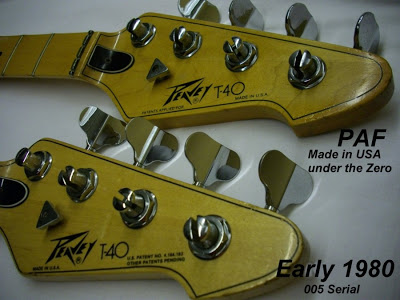
This is going to be a lengthy post, as I am going to cover my oldest T-40,
while Chip continues with the story.
The heads above show the subtle difference between the early (1977) one
and the later 1979
In the images below, you will see the "applied" dot markers that Chip refers
to in his story.
The top image shows the way they are now and if you look closely at the
bottom image, you will see that the dot is slightly raised.

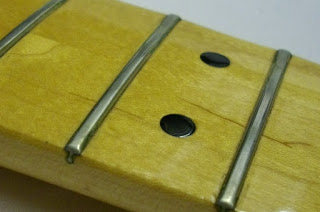
The tuners on the earlier one, are also very slightly different.
The top image shows early above and later below.
The middle image shows the earlier ones from above and the
image at the bottom, shows the later one from above.
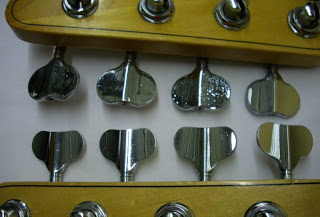
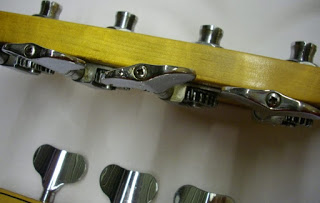
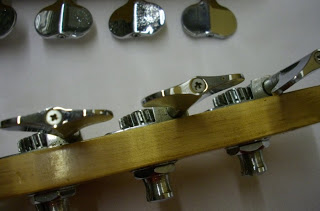
The early one also seems to have a nut at either end of the rod!
There are also markings on the neck and in the pocket - not sure
what they mean but I will check with Chip.
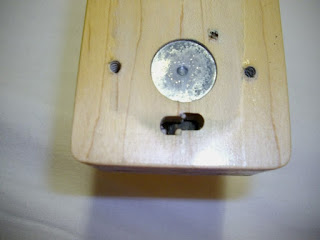
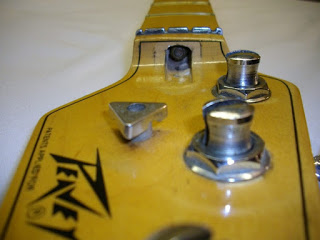

The pots are marked 77 and there are some scribbles and initials,
written in pencil. Brass bottomed pick-ups.
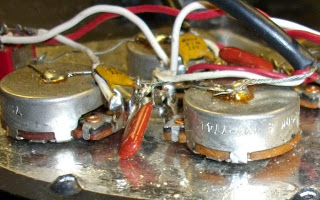

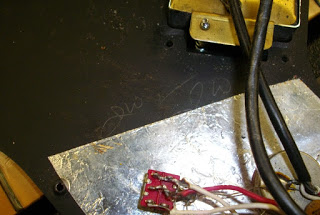
This, as you can see, is currently stripped for an overhaul -
not a restoration, as I like it the way it is but the switches
are a little worn.
Anyway, more input from me next time - back to what Chip
has to say.
I asked him this question - Did you set out to make the T-40 and T-60
a bit more special/innovative/different because of Peavey ethos/your
desire to lead in another direction or because it was deemed as a good
marketing standpoint - or a bit of both?
I was both a commercial artist and mechanical engineer when Peavey hired me
and we both had the desire to build things using the most accurate and cost
effective methods available, at the time.
We both felt that most guitar designs and manufacturing methods were incestuous
as everybody was copying what had been done for centuries.
I was a machinist, dragster builder and driver, and knew that metalworking methods
could make better and more economical instruments, than the antiquated processes
used by all the manufacturers around in 1975, when I started designing the T-series
guitars and basses.
Evidently, none of the luthiers had heard of Henry Ford, the father of mass production.
Things like the outline of the peghead and the ease of graphics were a well-kept secret
for years, and we kept it to ourselves.
As a commercial artist, I had been using rub-on lettering for years and naturally was
ready with that in mind when we designed the peghead.
The rub-on dot markers were successful because of the urethane paint we used
but a band touring the factory surprised the ladies putting on the dots and that
embarrassed Peavey into changing to the inlayed vinyl dots.
It would take a book to relate the many changes to production that we initiated
but several of the innovations have changed the manufacturing of guitars worldwide.
There are several holdouts, such as Gibson and Fender, who are trapped by the
words they published and had to keep up some old, less-than-smart, methods.
Fender hired me to bring them up into the modern age with Peavey, but CBS
changed management to ex-Yamaha executives who were thoroughly indoctrinated
by Japanese methods.
The wood supplier we chose to use was run by an old woodworker in Alabama who
told me, "Son, in woodworking you work to 1/16 of an inch, not thousandths.
We took him over to our Meridian, Mississippi facility and showed him that
metal-working techniques worked with wood, as long as you controlled the
moisture level.
He was sold on it and gave talks at wood industry meetings.
With this process, we had to return any machined wood to a humidity-controlled
room, each night until it got past the painting stage.
Hartley (Peavey) and I are both aircraft fans and knew that nothing takes more
abuse in the finish than aircraft sitting out in the sun and rain like airplanes.
We got Sherwin Williams work up a catalyzed urethane like DuPont's Emron paint,
which was way too expensive as it was "aircraft" related.
The only thing that we did for marketing reasons, even though we knew that it was
wrong, was to make individual saddles with height adjustment like Fender.
Peavey was afraid that Fender would use that against us while we were "the new kids
on the block".
There is no valid reason to support individual height adjustment for the strings.
The height of the strings should be in an arc that mimics the arch of the frets.
We chose to use an inexpensive method of tilting the neck for string height
adjustment, although most musicians refused to read any instructions.
All other design features were done for functionality and not tradition.
Chip.
Many thanks, Chip - I have more questions for next time.
Cheers. :)
- Peavey T-60 And T-40 Cases, Part Ii. . . . .
I asked Chip a couple of questions - How did the moulded case design come about, in order to conclude this piece about the cases and just get get an insight into the musical side of him, what his musical experiences were and did they influence...
- Peavey T-60 And T-40 Story And A Happy Christmas. . . . :)
Well, another year almost gone by again! Christmas is almost upon us, the shortest day of the year and tomorrow the days start to get longer. Yippeee! The next set of questions I asked Chip, were as usual, answered in great detail....
- Peavey T-60, T-40, Chip Todd - Hartley Peavey - "take From The Top!". . .
As I said in one of my previous posts, I am very lucky to have a substantial input from Chip, himself and I am grateful for the time he has put into it and he has indicated there is more to come. I you own, or have owned a Peavey T Series guitar,...
- Peavey T-60 And Eighty Thousand Visitors. . .
Hi to all out there. As of today, over 80500 visits have been made to my blog. So, thanks for dropping in - the story continues. I first saw a Peavey "T" in late '78 or early '79, a T-60 - I can't remember exactly when but I do...
- Peavey T-40 And T-60, The Begining. . . .
Peavey T-40 and T-60 - Bass & Guitar. How far is it back to the beginning?? 1822!! "You're Kidding"!!! Well, sort of! Way back, Thomas Blanchard invented a machine to make gun stocks all the same shape. See picture of Thomas and...
Guitar
Peavey T-60 and T-40 - the early days, continued. . . .
Once again, I am very grateful for Chip's considerable input into this.
He is prolific, which for me is great - the whole story unfolds in great detail.
He was editor of American Gunsmith for about 10 years and wrote
hundreds of articles, so he is no stranger to the keyboard!

This is going to be a lengthy post, as I am going to cover my oldest T-40,
while Chip continues with the story.
The heads above show the subtle difference between the early (1977) one
and the later 1979
In the images below, you will see the "applied" dot markers that Chip refers
to in his story.
The top image shows the way they are now and if you look closely at the
bottom image, you will see that the dot is slightly raised.


The tuners on the earlier one, are also very slightly different.
The top image shows early above and later below.
The middle image shows the earlier ones from above and the
image at the bottom, shows the later one from above.



The early one also seems to have a nut at either end of the rod!
There are also markings on the neck and in the pocket - not sure
what they mean but I will check with Chip.
The pots are marked 77 and there are some scribbles and initials,
written in pencil. Brass bottomed pick-ups.
This, as you can see, is currently stripped for an overhaul -
not a restoration, as I like it the way it is but the switches
are a little worn.
Anyway, more input from me next time - back to what Chip
has to say.
I asked him this question - Did you set out to make the T-40 and T-60
a bit more special/innovative/different because of Peavey ethos/your
desire to lead in another direction or because it was deemed as a good
marketing standpoint - or a bit of both?
I was both a commercial artist and mechanical engineer when Peavey hired me
and we both had the desire to build things using the most accurate and cost
effective methods available, at the time.
We both felt that most guitar designs and manufacturing methods were incestuous
as everybody was copying what had been done for centuries.
I was a machinist, dragster builder and driver, and knew that metalworking methods
could make better and more economical instruments, than the antiquated processes
used by all the manufacturers around in 1975, when I started designing the T-series
guitars and basses.
Evidently, none of the luthiers had heard of Henry Ford, the father of mass production.
Things like the outline of the peghead and the ease of graphics were a well-kept secret
for years, and we kept it to ourselves.
As a commercial artist, I had been using rub-on lettering for years and naturally was
ready with that in mind when we designed the peghead.
The rub-on dot markers were successful because of the urethane paint we used
but a band touring the factory surprised the ladies putting on the dots and that
embarrassed Peavey into changing to the inlayed vinyl dots.
It would take a book to relate the many changes to production that we initiated
but several of the innovations have changed the manufacturing of guitars worldwide.
There are several holdouts, such as Gibson and Fender, who are trapped by the
words they published and had to keep up some old, less-than-smart, methods.
Fender hired me to bring them up into the modern age with Peavey, but CBS
changed management to ex-Yamaha executives who were thoroughly indoctrinated
by Japanese methods.
The wood supplier we chose to use was run by an old woodworker in Alabama who
told me, "Son, in woodworking you work to 1/16 of an inch, not thousandths.
We took him over to our Meridian, Mississippi facility and showed him that
metal-working techniques worked with wood, as long as you controlled the
moisture level.
He was sold on it and gave talks at wood industry meetings.
With this process, we had to return any machined wood to a humidity-controlled
room, each night until it got past the painting stage.
Hartley (Peavey) and I are both aircraft fans and knew that nothing takes more
abuse in the finish than aircraft sitting out in the sun and rain like airplanes.
We got Sherwin Williams work up a catalyzed urethane like DuPont's Emron paint,
which was way too expensive as it was "aircraft" related.
The only thing that we did for marketing reasons, even though we knew that it was
wrong, was to make individual saddles with height adjustment like Fender.
Peavey was afraid that Fender would use that against us while we were "the new kids
on the block".
There is no valid reason to support individual height adjustment for the strings.
The height of the strings should be in an arc that mimics the arch of the frets.
We chose to use an inexpensive method of tilting the neck for string height
adjustment, although most musicians refused to read any instructions.
All other design features were done for functionality and not tradition.
Chip.
Many thanks, Chip - I have more questions for next time.
Cheers. :)
- Peavey T-60 And T-40 Cases, Part Ii. . . . .
I asked Chip a couple of questions - How did the moulded case design come about, in order to conclude this piece about the cases and just get get an insight into the musical side of him, what his musical experiences were and did they influence...
- Peavey T-60 And T-40 Story And A Happy Christmas. . . . :)
Well, another year almost gone by again! Christmas is almost upon us, the shortest day of the year and tomorrow the days start to get longer. Yippeee! The next set of questions I asked Chip, were as usual, answered in great detail....
- Peavey T-60, T-40, Chip Todd - Hartley Peavey - "take From The Top!". . .
As I said in one of my previous posts, I am very lucky to have a substantial input from Chip, himself and I am grateful for the time he has put into it and he has indicated there is more to come. I you own, or have owned a Peavey T Series guitar,...
- Peavey T-60 And Eighty Thousand Visitors. . .
Hi to all out there. As of today, over 80500 visits have been made to my blog. So, thanks for dropping in - the story continues. I first saw a Peavey "T" in late '78 or early '79, a T-60 - I can't remember exactly when but I do...
- Peavey T-40 And T-60, The Begining. . . .
Peavey T-40 and T-60 - Bass & Guitar. How far is it back to the beginning?? 1822!! "You're Kidding"!!! Well, sort of! Way back, Thomas Blanchard invented a machine to make gun stocks all the same shape. See picture of Thomas and...
